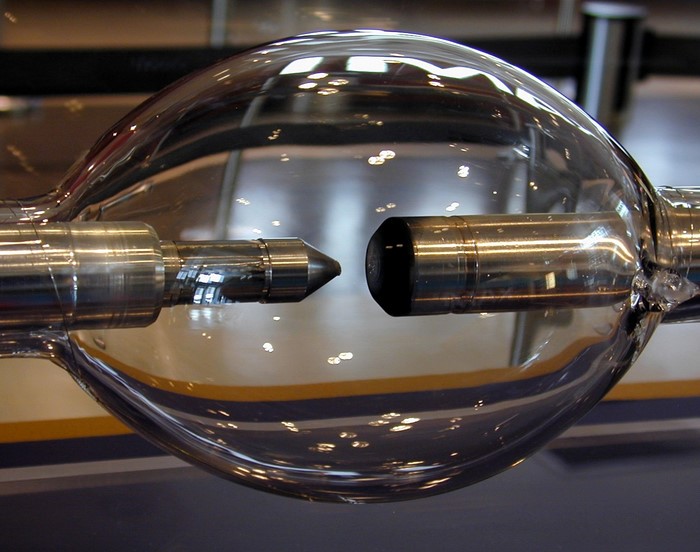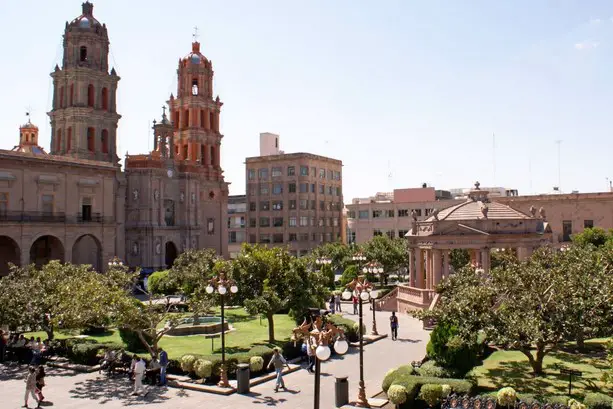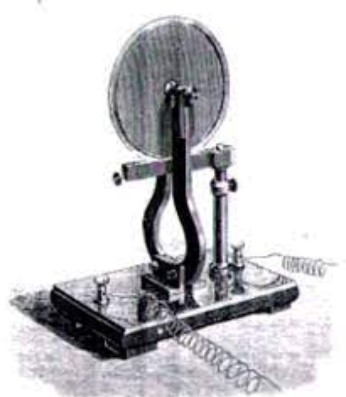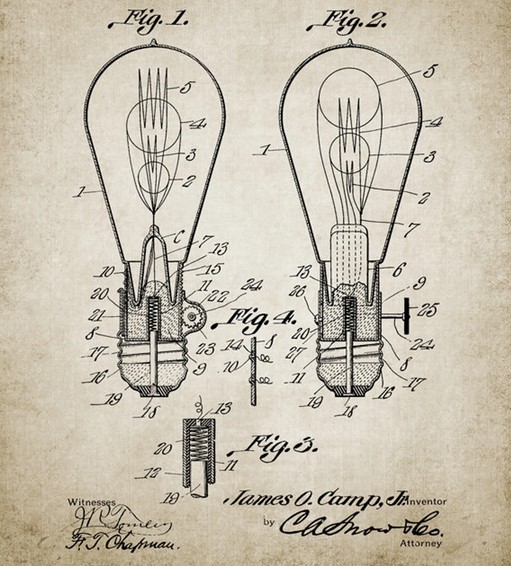Podcast: Play in new window | Download
Subscribe: Apple Podcasts | RSS
 It was a chilly November night in 1877. The San Luis Potosí Scientific and Literary Institute was holding a charity event and it had a special surprise for its attendees. Two of Mexico’s scientific geniuses had prepared quite a spectacle for the well-heeled members of potosino society. One of the illustrious men was Pedro Dionisio de la Garza Cepeda who hailed from Monterrey and was the first Mexican in history to earn a doctorate in physics. The other scientist present was a man named José Francisco Estrada Munguía who was well known locally because he was born and raised in San Luis Potosí. At the designated time, the two men stood before a large apparatus that looked like it belonged in an old Frankenstein movie. Estrada pulled the lever and the people at the charity event gasped in amazement. Before them was the first electric arc light ever to be demonstrated in the Americas. This dazzled the wealthy attendees who had never seen artificial light contained in a glass lamp before. After the oohs and aahs of the crowd subsided, José Estrada pulled back the lever and “turned off” the light. A few people at this historic event had heard of experiments with electric lights being conducted in Europe, but nothing was so refined and controlled as this. Estrada had put decades of work into this and with the help of de la Garza, the two came up with a perfected final product. Later that year they managed to illuminate the front and one of the sides of the Government Palace in the Plaza de Armas of San Luis Potosí. The years spending late nights in makeshift laboratories had finally paid off for José Estrada. It is important to note that Thomas Edison’s first successful ignition of an incandescent light bulb took place on October 22, 1879, almost two full years after the demonstration at the San Luis Potosí Scientific and Literary Institute. Edison, however, is credited with the lightbulb’s invention while Estrada seems to have been completely lost to history. Most Mexicans today have never even heard of him.
It was a chilly November night in 1877. The San Luis Potosí Scientific and Literary Institute was holding a charity event and it had a special surprise for its attendees. Two of Mexico’s scientific geniuses had prepared quite a spectacle for the well-heeled members of potosino society. One of the illustrious men was Pedro Dionisio de la Garza Cepeda who hailed from Monterrey and was the first Mexican in history to earn a doctorate in physics. The other scientist present was a man named José Francisco Estrada Munguía who was well known locally because he was born and raised in San Luis Potosí. At the designated time, the two men stood before a large apparatus that looked like it belonged in an old Frankenstein movie. Estrada pulled the lever and the people at the charity event gasped in amazement. Before them was the first electric arc light ever to be demonstrated in the Americas. This dazzled the wealthy attendees who had never seen artificial light contained in a glass lamp before. After the oohs and aahs of the crowd subsided, José Estrada pulled back the lever and “turned off” the light. A few people at this historic event had heard of experiments with electric lights being conducted in Europe, but nothing was so refined and controlled as this. Estrada had put decades of work into this and with the help of de la Garza, the two came up with a perfected final product. Later that year they managed to illuminate the front and one of the sides of the Government Palace in the Plaza de Armas of San Luis Potosí. The years spending late nights in makeshift laboratories had finally paid off for José Estrada. It is important to note that Thomas Edison’s first successful ignition of an incandescent light bulb took place on October 22, 1879, almost two full years after the demonstration at the San Luis Potosí Scientific and Literary Institute. Edison, however, is credited with the lightbulb’s invention while Estrada seems to have been completely lost to history. Most Mexicans today have never even heard of him.
José Francisco Javier Severiano Adolfo Estrada Munguía was born in San Luis Potosí on February 11, 1838, to Francisco Javier Estrada Zapara and Luisa Munguía Mojica. His father was a respected doctor in the community and his mother was the daughter of a local merchant. Little else is known about José Estrada’s immediate family other than he had a sister who married well and moved in important social circles later in life. When Estrada was born, Anastasio Bustamante was president of Mexico, and it was only 16 years after Mexico had become independent from Spain. Texas had recently declared itself a Republic and Mexico had not yet lost its other northern territories to the United States. Young José had a precocious scientific mind as a child to the delight of his  academically-inclined parents. In the year 1861 when José Estrada was 23 years old, he finally finished his studies and became a pharmacist. While in school he pursued many interests including mechanics, hydrodynamics, the movement of gases, statics, kinematics, dynamics, electromagnetism, thermodynamics, acoustics, meteorology, electrochemistry, optics, and medicine. A Mexican renaissance man in his own right, he had a hard time settling on pharmacy as a profession, although he spent much time after work into the wee hours of the morning pursuing his other interests. In the back room of the drug store where he worked, he set up a crude lab to conduct experiments involving electromagnetism. Estrada usually worked alone and like Nikola Tesla he was not much of a people person and lived the life of a hermit, with a laser focus on his scientific pursuits.
academically-inclined parents. In the year 1861 when José Estrada was 23 years old, he finally finished his studies and became a pharmacist. While in school he pursued many interests including mechanics, hydrodynamics, the movement of gases, statics, kinematics, dynamics, electromagnetism, thermodynamics, acoustics, meteorology, electrochemistry, optics, and medicine. A Mexican renaissance man in his own right, he had a hard time settling on pharmacy as a profession, although he spent much time after work into the wee hours of the morning pursuing his other interests. In the back room of the drug store where he worked, he set up a crude lab to conduct experiments involving electromagnetism. Estrada usually worked alone and like Nikola Tesla he was not much of a people person and lived the life of a hermit, with a laser focus on his scientific pursuits.
In the first half of the 1860s, José Estrada immersed himself in serious research on dynamic generation of electricity, with the end goal in mind to create an electricity-generating machine, commonly known as a dynamo. This sort of research was not well recognized internationally with only a few scientists engaging in dynamo research. Estrada wanted to bounce his ideas off others and was in contact with various scientists and inventors around the world. One such inventor was Dr. Henry Wilde of Manchester, England. Estrada sent him a detailed paper explaining his research and detailed drawings on how to build a prototype for his electricity-generating dynamo. Wilde later presented a similar paper before the Royal Academy of Sciences in London and was later credited as being one of the pioneers of the dynamo. Estrada’s frustration with intellectual theft continued. In 1868 he built a prototype that served as an electric motor, but when he sent the plans for the definitive model to a company in France, he never received an answer. Then in 1871, before the Academy of Sciences in Paris, a man from Belgium named Zénobe Gramme unveiled a machine practically identical to the one described in Estrada’s plan which was called Gramme’s Dynamo and is considered the first electrical generator ever to be used for industrial purposes. Gramme was hailed as an unsuspecting genius. He had no formal education and was known in his local area as a tinkerer. People were amazed that this Belgian had come up with such a sophisticated machine. Ironically, it was thanks to the so-called Gramme’s Dynamo, of which the San Luis government bought two, that Estrada and de la Garza achieved their 1877 feat of lighting the first electric lamp.
 During the latter decades of the 1800s José Estrada also did research on solar energy, steam engines, thermometers, telegraphs, barometers, electric pianos, and even equipment to anticipate earthquakes and volcanic eruptions. He kept volumes of handwritten notebooks and stacks of plans for inventions. Most of his inventions or ideas never left the prototype stage. Unlike Thomas Edison who was able to charm backers to secure funding and was able to build for-profit enterprises to fund his work, Estrada had a hard time convincing Mexican investors to put money into his projects. He was much like Nikola Tesla in that regard. Estrada couldn’t go to Mexican universities at the time for help because they focused more on technical training and did not put any importance on research and development. Estrada’s frustration coming from lack of recognition and financing began in the 1860s during the period in Mexican history called the Second French Intervention. This is when the Mexican elite class installed an Austrian prince to rule Mexico as a monarch known to history as Emperor Maximilian. The European emperor had great plans to modernize Mexico and part of this modernization included the organization of the Science and Arts Commission of Mexico. This attracted some of the brightest minds of the whole country to Mexico City where they had a place to share ideas and collaborate on important projects. Emperor Maximilian encouraged scientists from Europe and the United States to lecture at commission events. José Estrada was shut out of all of this, though, and purely for political reasons. Estrada was good friends with Benigno Arriaga, the founder of the Liberal Party of San Luis Potosí and a vocal opponent of the Second Empire. Estrada was not alone in being left out. Many intellectuals whose beliefs were not aligned with the conservative politics of Maximilian found it difficult to have a voice during these times. As an interesting aside, when Emperor Maximilian was about to face a firing squad after his overthrow, José Estrada’s sister, who was an important fixture in Mexican society at the time, joined forces with an Austrian princess to plead with Benito Juárez to spare the life of the monarch. Apparently, Estrada’s sister had as much influence at the national level as Estrada had because Maximilian swiftly faced his untimely fate at the hands of his executioners.
During the latter decades of the 1800s José Estrada also did research on solar energy, steam engines, thermometers, telegraphs, barometers, electric pianos, and even equipment to anticipate earthquakes and volcanic eruptions. He kept volumes of handwritten notebooks and stacks of plans for inventions. Most of his inventions or ideas never left the prototype stage. Unlike Thomas Edison who was able to charm backers to secure funding and was able to build for-profit enterprises to fund his work, Estrada had a hard time convincing Mexican investors to put money into his projects. He was much like Nikola Tesla in that regard. Estrada couldn’t go to Mexican universities at the time for help because they focused more on technical training and did not put any importance on research and development. Estrada’s frustration coming from lack of recognition and financing began in the 1860s during the period in Mexican history called the Second French Intervention. This is when the Mexican elite class installed an Austrian prince to rule Mexico as a monarch known to history as Emperor Maximilian. The European emperor had great plans to modernize Mexico and part of this modernization included the organization of the Science and Arts Commission of Mexico. This attracted some of the brightest minds of the whole country to Mexico City where they had a place to share ideas and collaborate on important projects. Emperor Maximilian encouraged scientists from Europe and the United States to lecture at commission events. José Estrada was shut out of all of this, though, and purely for political reasons. Estrada was good friends with Benigno Arriaga, the founder of the Liberal Party of San Luis Potosí and a vocal opponent of the Second Empire. Estrada was not alone in being left out. Many intellectuals whose beliefs were not aligned with the conservative politics of Maximilian found it difficult to have a voice during these times. As an interesting aside, when Emperor Maximilian was about to face a firing squad after his overthrow, José Estrada’s sister, who was an important fixture in Mexican society at the time, joined forces with an Austrian princess to plead with Benito Juárez to spare the life of the monarch. Apparently, Estrada’s sister had as much influence at the national level as Estrada had because Maximilian swiftly faced his untimely fate at the hands of his executioners.
There are claims that José Estrada once collaborated with Thomas Edison sometime in the 1880s when Edison was in Mexico. As discussed in Mexico Unexplained episode number 227 https://mexicounexplained.com/was-thomas-edison-really-a-mexican/ there may be evidence showing that Edison himself was Mexican and was born in Sombrerete, Zacatecas. If a meeting did take place, it would have been interesting to know how the two communicated given that Estrada didn’t speak English. Perhaps this would add more to solidify the claim that Edison was really not an American. According to those who have investigated the possibility of a series of meetings between the two electrical engineering geniuses, Estrada was once again left out in the cold. Mexican author and science professor Dr. José Refugio who investigated the Edison-Estrada meetings, contends that Edison walked away from his Mexican collaborations with new ideas and new plans for dazzling inventions and didn’t share the fame or fortune with José Estrada.
 Despite many odds being stacked against him, José Estrada did manage to come out with some inventions and won a little notoriety while he was still alive. His list of inventions includes: a minimum barometer; a metal thermometer; a new way to produce static electricity; an instrument for measuring the speed of electricity; the use of solar rays as motive power; the ice-powered steam engine; an explanation of the movement of the Crookes radiometer in rarefied gases; a new telegraph; several new duplex telegraph transmission systems; and a small incandescent lamp. He was made a member of the Paris Academy of Sciences, despite never applying to become a member, possibly as a way of making up for the Gramme Dynamo fiasco. Estrada was awarded a diploma from the Physical and Chemical Sciences section of the United States Department of Public Works. The Natural History Society of Mexico City named him an Honorary Member on September 11, 1879, dispensing with the application that was rarely granted. In addition, today the science category of Mexico’s November 20 Prize bears his name, as does a small side street in the Tequis neighborhood in the city of San Luis Potosí. Modern scholars who have pored over Estrada’s work, like Dr. José Refugio mentioned previously, contend that José Estrada’s accomplishments are on par with Nikola Tesla’s.
Despite many odds being stacked against him, José Estrada did manage to come out with some inventions and won a little notoriety while he was still alive. His list of inventions includes: a minimum barometer; a metal thermometer; a new way to produce static electricity; an instrument for measuring the speed of electricity; the use of solar rays as motive power; the ice-powered steam engine; an explanation of the movement of the Crookes radiometer in rarefied gases; a new telegraph; several new duplex telegraph transmission systems; and a small incandescent lamp. He was made a member of the Paris Academy of Sciences, despite never applying to become a member, possibly as a way of making up for the Gramme Dynamo fiasco. Estrada was awarded a diploma from the Physical and Chemical Sciences section of the United States Department of Public Works. The Natural History Society of Mexico City named him an Honorary Member on September 11, 1879, dispensing with the application that was rarely granted. In addition, today the science category of Mexico’s November 20 Prize bears his name, as does a small side street in the Tequis neighborhood in the city of San Luis Potosí. Modern scholars who have pored over Estrada’s work, like Dr. José Refugio mentioned previously, contend that José Estrada’s accomplishments are on par with Nikola Tesla’s.
José Francisco Estrada Munguía died broke and underappreciated on February 12, 1905, just one day after his 67th birthday. He was buried in a common grave in Mexico City. There is a movement in the Mexican scientific community to have the remains of this great inventor moved to the Rotunda of Illustrious Persons in the Dolores Cemetery of Mexico City. That would be an amazing feat given that Estrada doesn’t even have a Wikipedia page. Perhaps sometime soon this amazing Mexican scientist will get the recognition that has been so long in coming.
REFERENCES
Rodriguez y Morgado. “Se cumple otro aniversario de uno de los más grandes inventores mexicanos.” En Saber Sin Fin, 6 Feb 2021.
